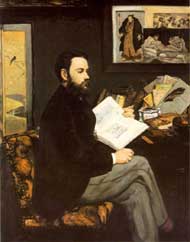After visiting the fabulous Musee d”Orsay recently and studying the interpretive materials therein I came to a fuller understanding of the history of art in Paris.
From the early 1500’s Paris was a hub of fashion, literature and art of all sorts. In the seventeenth century the pace picked up, and naturalism as a movement was born.
Naturalism is a period of art, and a philosophical movement which considered “nature” as being the origins of everything in the universe – rather than God. A rather shocking concept at the time indeed! France was truly scandalized!!!
Naturalist artists created faithful imitations of nature as an expression of reality, not for religious purposes, or uses. Painters began to paint for public profit rather than dispensations from the Church.

Portrait of Emile Zola by Claude Manet.
Emile Zola burst onto this “naturalist” scene with the publication of 20 novels between the years 1871 and 1893. The books follow the story of one family during the Second French Empire. (The Second French Empire and it’s architectural style is named after the reign of Napoleon III’s Second Empire in the third quarter of the 19th century.)
Continue reading →



